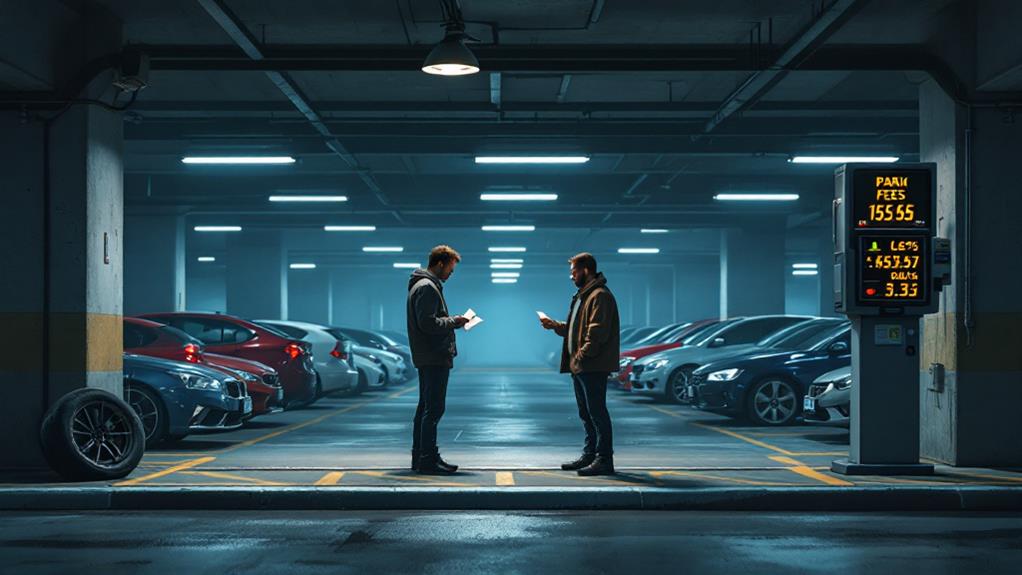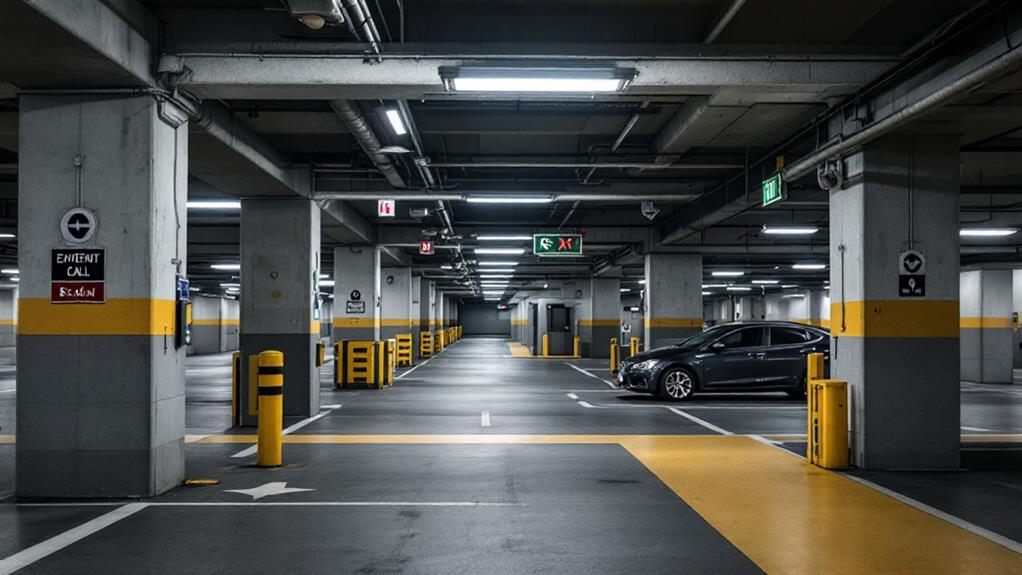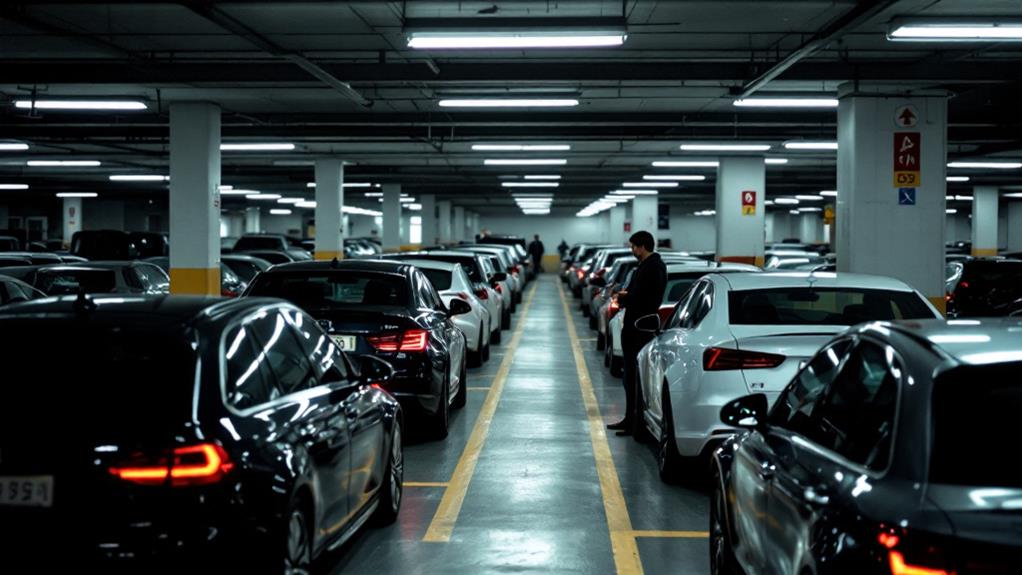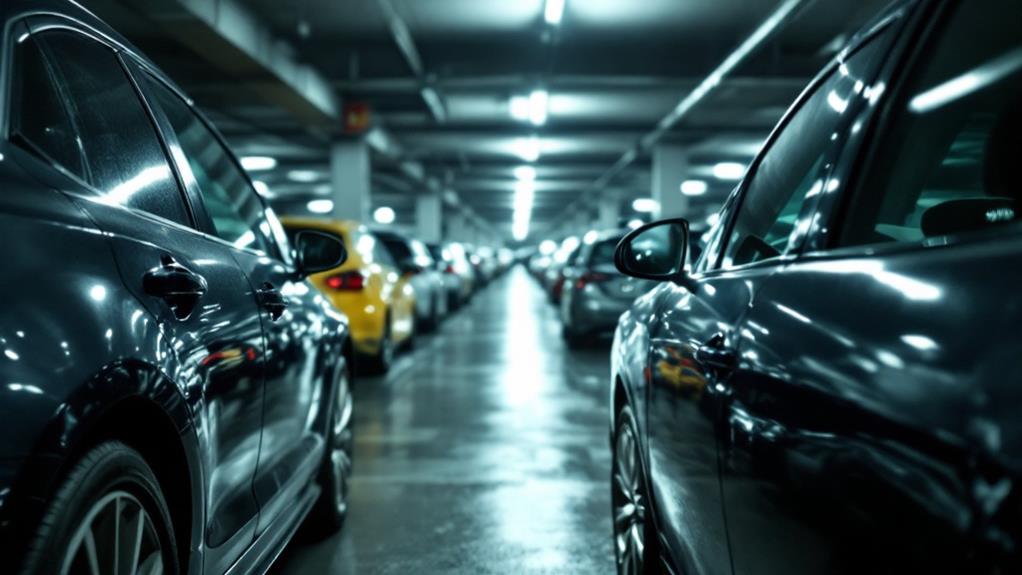How Public Garages Handle Security and Surveillance
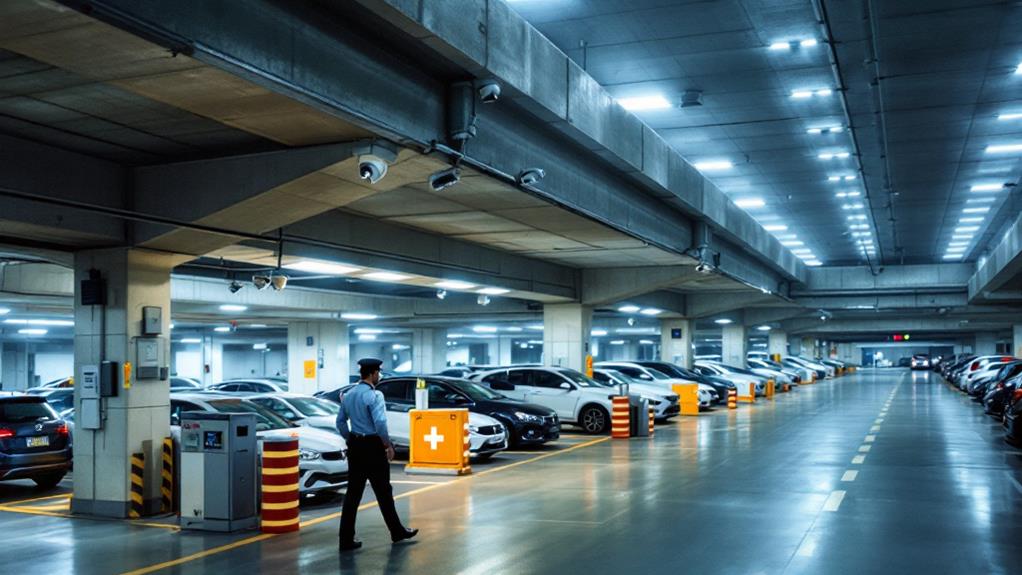
Public garages employ a thorough approach to security and surveillance. You'll find strategically placed cameras monitoring entrances, exits, and parking areas. Access control systems like card readers and automated gates restrict entry to authorized vehicles. Well-designed lighting enhances visibility and deters crime. Trained security personnel conduct regular patrols and respond to incidents promptly. Emergency protocols and call boxes guarantee quick assistance when needed. Advanced technologies, including AI-powered facial recognition and license plate readers, strengthen surveillance capabilities. These measures work together to create a safe environment for both vehicles and visitors. Exploring the complexities of each security component reveals a fascinating web of protection.
Camera Placement Strategies
How can parking garages maximize their security coverage with strategic camera placement? To achieve extensive surveillance, you'll find cameras installed at key points throughout the parking garage. Entrance and exit areas are prime locations for security cameras equipped with license plate recognition technology. These devices capture significant data on vehicles entering and exiting the facility.
You'll notice cameras strategically positioned along perimeter walls and fences to monitor for unauthorized access. Stairwells and elevators, known high-crime areas, are also under constant video monitoring. Parking levels themselves are covered, with cameras focusing on poorly lit areas and blind spots.
To optimize coverage, parking lot security systems utilize flexible cameras that can pan, tilt, and zoom. This flexibility allows security personnel to focus on specific areas when needed. Some garages even deploy mobile surveillance units with high-definition cameras and powerful lights for added flexibility.
Modern parking garage security goes beyond basic video monitoring. Many facilities now incorporate intelligent video analytics and motion detection technology. These advanced systems can automatically identify suspicious activity, track individuals, and trigger alerts, enhancing overall security and surveillance capabilities.
Access Control Systems
Many public parking garages employ sophisticated access control systems to enhance security and regulate entry. You'll often encounter a combination of physical barriers and electronic components designed to monitor and control vehicle access. These systems typically include:
- Gates or barriers that open only for authorized vehicles
- Card readers for permit holders or regular customers
- Automated license plate recognition (ALPR) cameras
- Touchless entry options using Bluetooth or mobile apps
- Tailgating prevention measures like anti-pass back systems
Access control systems work together to create a secure environment. As you approach the garage, ALPR cameras scan your vehicle's plate, cross-referencing it with a database of authorized users. If you're approved, the gate opens automatically. For added convenience, you might use a mobile app or Bluetooth-enabled device to gain entry without physical contact.
Garage operators can remotely monitor and manage these systems in real-time, adjusting access permissions and responding to security incidents as needed. They can also implement tailgating prevention solutions, such as audio/visual alarms, to deter unauthorized entry attempts. By integrating these technologies, public parking garages create a sturdy security infrastructure that protects both vehicles and patrons.
Lighting Design for Safety
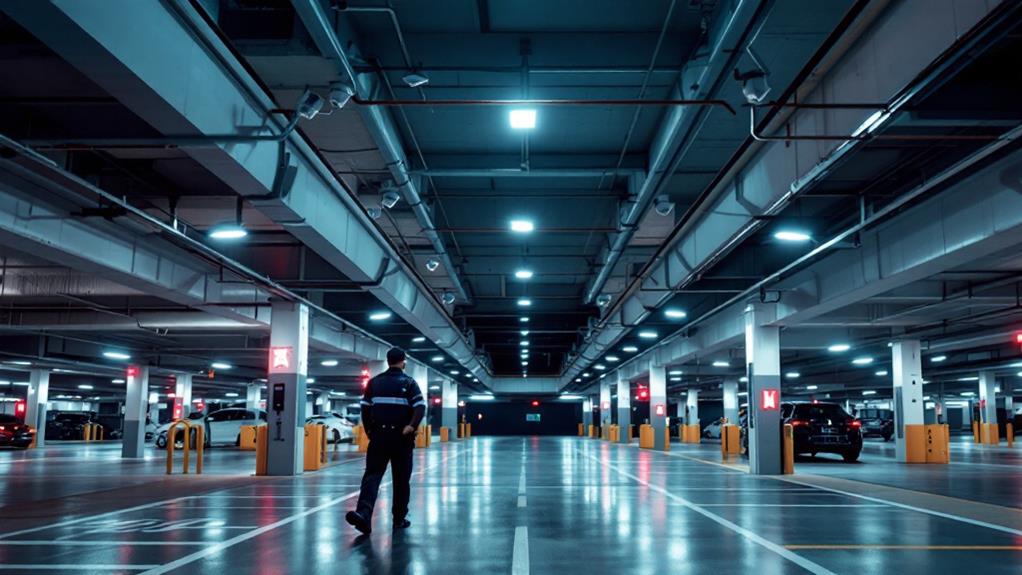
While access control systems protect the perimeter, effective lighting design safeguards the interior of public parking garages. You'll find that adequate and uniform lighting throughout these structures is vital for visibility and deterring criminal activity. Parking garages typically employ high-efficiency LED fixtures, strategically positioned to eliminate dark spots and provide sufficient illumination.
When you're designing lighting for a parking garage, you must meet industry standards. This includes maintaining a minimum illuminance of 5 lux on driving aisles and 2 lux in parking stalls. To optimize energy efficiency while maintaining safety, many lighting systems incorporate motion sensors or time-based controls.
Proper lighting design goes beyond mere illumination. The placement, type, and intensity of fixtures play a significant role in improving overall security and the perception of safety. You'll want to carefully consider these factors when planning your garage's lighting system. By focusing on fixture placement, type, and intensity, you can create a well-lit environment that enhances visibility, deters criminal activity, and provides a sense of security for garage users.
Security Personnel and Patrols
A crucial component of public garage security is the presence of trained security personnel and regular patrols. When you park in a public garage, you'll likely encounter security guards performing various duties to guarantee your safety and the protection of your vehicle.
Security guards in parking garages are trained to:
- Monitor for suspicious activity
- Respond to incidents quickly
- Provide customer assistance
- Make sure of compliance with rules and regulations
- Deter potential criminal behavior
These professionals are equipped with tools like two-way radios and flashlights to effectively carry out their responsibilities. You'll often see them conducting regular patrols throughout the facility, either on foot or in marked vehicles. This visible presence serves as a deterrent to potential wrongdoers and helps create a sense of safety for garage users like you.
Many parking garages employ both stationary and roving security guards to provide thorough surveillance coverage. This strategy ensures that all areas of the garage are regularly monitored and that help is always within reach. By combining trained personnel with other security measures, public garages strive to create a safe environment for you and your vehicle.
Emergency Response Protocols
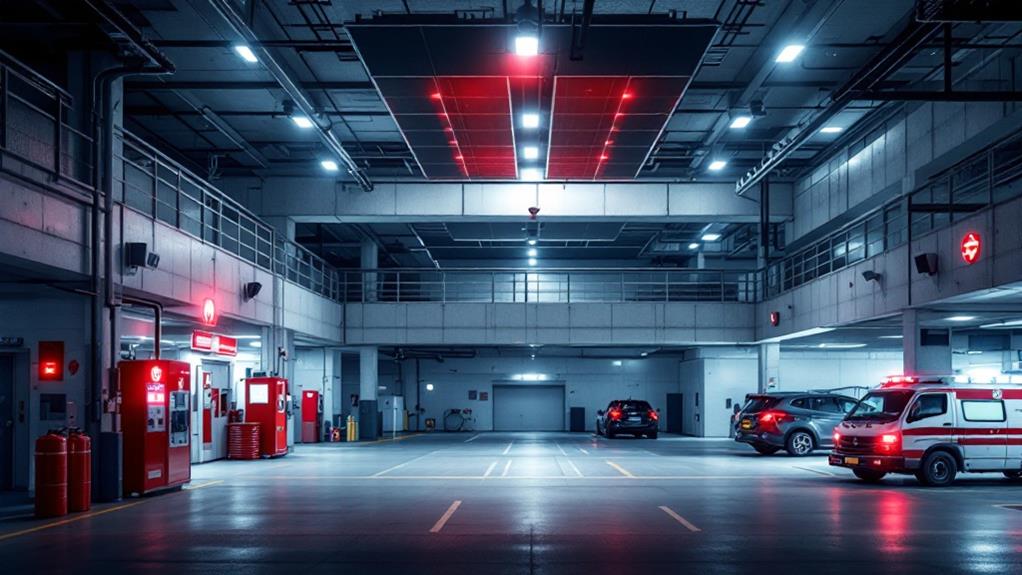
Emergency response readiness is a critical aspect of public garage security. You'll find that parking garage operators have established thorough protocols to swiftly address security incidents. These measures guarantee a rapid response when you need it most.
If an emergency occurs, centralized monitoring systems can instantly alert law enforcement, minimizing response times. Security personnel are trained to quickly dispatch to the scene or contact local authorities as needed. You'll notice security guards throughout the facility, ready to follow specific procedures for safely evacuating the premises and isolating potential threats until police arrive.
For your convenience, emergency call boxes are strategically placed throughout the garage, allowing you to summon help at the touch of a button. These pre-programmed devices connect directly to security personnel or emergency services, ensuring immediate assistance.
To maintain the effectiveness of these protocols, parking garage operators conduct regular security audits and drills. This ongoing process helps refine emergency response plans and keeps staff prepared to handle critical situations efficiently. By prioritizing these measures, public garages aim to provide you with a secure environment and peace of mind during your visit.
Technological Advancements in Surveillance
Over the past decade, technological advancements have revolutionized surveillance systems in public garages. You'll find state-of-the-art security cameras equipped with AI-powered facial recognition and license plate recognition capabilities, enhancing crime prevention efforts. These high-resolution cameras provide clear footage even in low-light conditions, improving the quality of evidence for security personnel.
Public parking garages are embracing wireless and solar-powered security camera systems, offering autonomous operation and remote video monitoring. This allows for quick retrieval of footage and 24/7 surveillance by security professionals. The integration of parking lot security measures with access control and lighting systems creates an extensive approach to garage safety.
AI-powered cameras with facial and license plate recognition
High-resolution footage in low-light conditions
Wireless and solar-powered camera systems
Cellular connectivity for rapid deployment
Integration with other security systems
These technological advancements have greatly improved video monitoring capabilities in parking lots. You'll benefit from increased safety and security measures, as parking garages utilize these innovations to create safer environments for visitors and their vehicles.
Data Management and Privacy
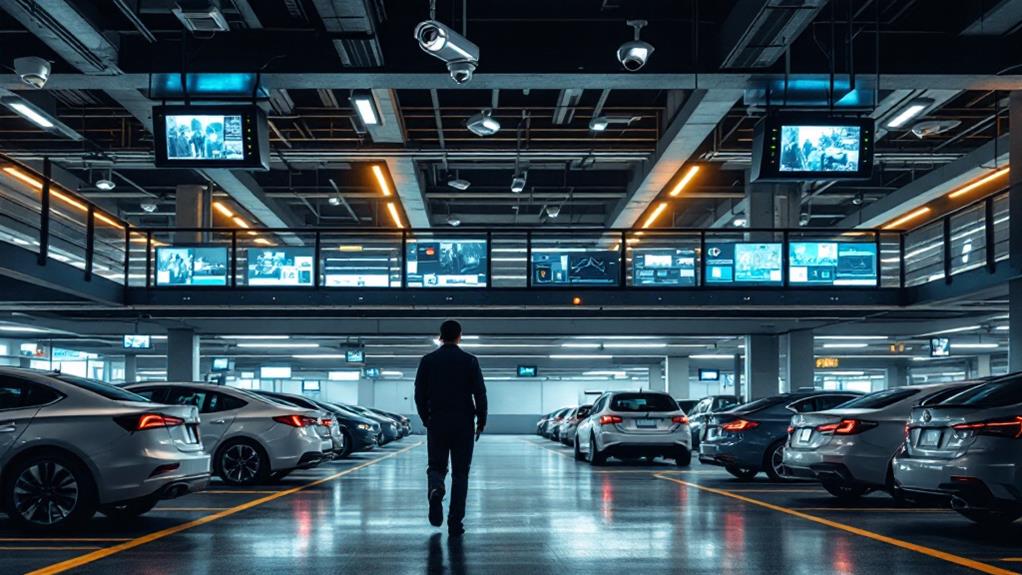
Data management and privacy concerns have become paramount in public garage surveillance systems. As a customer, you should be aware that parking garage operators must adhere to strict data privacy regulations when collecting and storing video surveillance footage. This guarantees the protection of your personal information.
While many garages employ advanced analytics and facial recognition technology, they're required to implement appropriate safeguards to prevent unauthorized access or misuse of your data. You'll notice that garages are obligated to clearly disclose their video surveillance policies and obtain your consent before capturing and storing your personal data.
To maintain data security, operators must develop sturdy data management protocols. These include securely storing video footage, restricting access, and promptly deleting recordings once the data retention period expires. You can expect parking garages to proactively communicate their data privacy measures, which helps build customer trust and address concerns about surveillance technology use.
As a customer, you have the right to know how your data is being handled. Don't hesitate to ask about data access policies and security measures in place to protect your privacy while using public parking facilities.
Integrating Multiple Security Measures
While data management is indispensable, it's just one piece of the security puzzle in public parking garages. To create an all-encompassing security solution, these facilities integrate multiple measures that work together seamlessly. You'll find a range of technologies and personnel working in tandem to keep you and your vehicle safe.
- High-resolution security cameras with night vision and advanced analytics
- Access control systems regulating entry and exit
- Visible security personnel patrolling the premises
- Emergency call boxes strategically placed throughout the facility
- Automated gates and barriers to manage traffic flow
These elements combine to create a formidable security network. Surveillance cameras monitor activity 24/7, capturing clear footage even in low-light conditions. Access control systems track who enters and exits the garage, while security personnel provide a human presence to deter potential wrongdoers and assist customers. If you ever feel unsafe, you can quickly reach help using the emergency call boxes.
User Education and Awareness
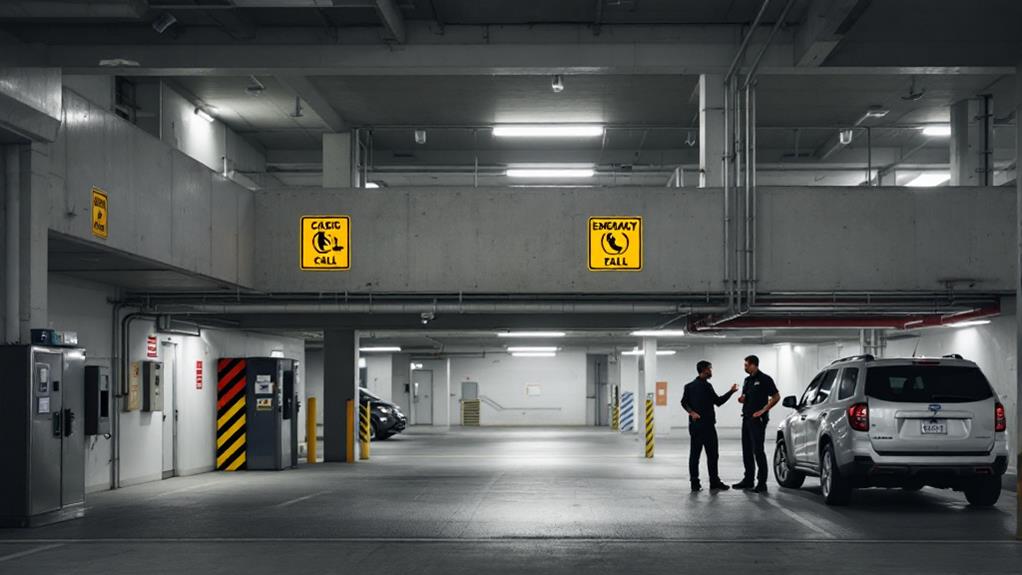
A key component of public garage security is user education and awareness. You'll often find signage and brochures throughout public garages, informing you about the security features in place for your protection. These materials are designed to keep you informed and alert while using the facility.
Safety announcements and reminders are regularly broadcast to reinforce the importance of vigilance and responsible behavior. You're encouraged to report any suspicious activity or security concerns to on-site staff or emergency services immediately. This helps maintain a safe environment for all users.
User awareness campaigns focus on personal security tips, such as keeping valuables out of sight and walking in well-lit areas. By following these guidelines, you can significantly reduce your risk of becoming a target for crime.
Public garages also implement outreach programs to engage the community and build a sense of shared responsibility. This collaborative approach ensures that everyone plays a role in maintaining a secure parking environment. Remember, your awareness and cooperation are essential in complementing the garage's security measures and creating a safer space for all users.
Maintenance of Security Infrastructure
The backbone of any public garage's security system lies in its well-maintained infrastructure. To ensure continuous and reliable operation, parking lot operators conduct regular inspections and maintenance of security cameras, lighting, and access control systems. This ongoing upkeep is essential for maintaining optimal performance and minimizing downtime.
Key aspects of security infrastructure maintenance include:
- Routine software updates and hardware replacements
- Preventive maintenance tasks like cleaning lenses and adjusting camera angles
- Testing backup power sources
- Performance monitoring and comprehensive maintenance logs
- Dedicated on-site technicians or contracted service providers
These measures help keep the surveillance system up-to-date and effective against evolving security threats. By implementing preventive maintenance practices, you're guaranteeing that your parking garage's security equipment remains in top condition. This proactive approach allows you to identify areas for improvement and address any issues before they become major problems.
